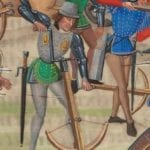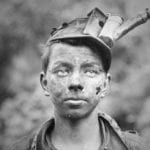 Creepy
Creepy  Creepy
Creepy  Technology
Technology 10 Scientific Breakthroughs of 2025 That’ll Change Everything
 Our World
Our World 10 Ways Icelandic Culture Makes Other Countries Look Boring
 Misconceptions
Misconceptions 10 Common Misconceptions About the Victorian Era
 Mysteries
Mysteries 10 Strange Unexplained Mysteries of 2025
 Miscellaneous
Miscellaneous 10 of History’s Most Bell-Ringing Finishing Moves
 History
History 10 Great Escapes That Ended Right Back in Captivity
 Weird Stuff
Weird Stuff 10 Fascinating Things You Might Not Know About Spiders
 Food
Food 10 Everyday Foods You Didn’t Know Were Invented by the U.S. Military
 History
History 10 Odd Things Colonial Americans Kept at Home
 Creepy
Creepy 10 More Representations of Death from Myth, Legend, and Folktale
 Technology
Technology 10 Scientific Breakthroughs of 2025 That’ll Change Everything
 Our World
Our World 10 Ways Icelandic Culture Makes Other Countries Look Boring
Who's Behind Listverse?

Jamie Frater
Head Editor
Jamie founded Listverse due to an insatiable desire to share fascinating, obscure, and bizarre facts. He has been a guest speaker on numerous national radio and television stations and is a five time published author.
More About Us Misconceptions
Misconceptions 10 Common Misconceptions About the Victorian Era
 Mysteries
Mysteries 10 Strange Unexplained Mysteries of 2025
 Miscellaneous
Miscellaneous 10 of History’s Most Bell-Ringing Finishing Moves
 History
History 10 Great Escapes That Ended Right Back in Captivity
 Weird Stuff
Weird Stuff 10 Fascinating Things You Might Not Know About Spiders
 Food
Food 10 Everyday Foods You Didn’t Know Were Invented by the U.S. Military
 History
History 10 Odd Things Colonial Americans Kept at Home
Top 10 Prisoner Riots and Revolutions in History
Warning, this may shock you to hear, but: prisons are generally not super fun places to be (no matter what Martin Nash said to the Dunder Mifflin staff). Whether they’re for citizens or enemy combatants, most prisons focus the vast majority of their resources on keeping prisoners in, not keeping prisoners happy.
Depending on your views and the specific situation, this rough treatment can be either righteous justice or rights violations. Regardless, at times, the powder keg has blown (sometimes literally), and prisoners have staged full-on riots. These rarely end well.
This list ranks ten of the most interesting prison riots ever. Whether by virtue of their brutality, their infamy, their legacy, or their utter insanity, they’ve earned their spot here as the top 10 prison riots.
Related: 10 Inescapable Prisons People Somehow Escaped From
10 A Football Massacre
The Carandiru Massacre is one of the most notorious prison riots in history and an equally notorious human rights violation. Within hours, 111 inmates were dead, and, as crazy as it sounds, it all started because of a soccer match.
It began with a soccer match in the prison’s yard, which ended with hostility and, eventually, a large, open brawl. The brawl started to turn against the responding prison guards, and the prison director took no chances. Within the hour, the military had responded to the director’s call and assumed full control of the prison. In an egregious human rights violation, soldiers then returned the prisoners to their cells, locked them in, and executed them one by one. They also commanded their attack dogs to finish off any wounded inmates in the incident’s makeshift infirmary.
Perhaps the most tragic facet to the whole affair is that Carandiru was merely a detention center, meaning its prisoners were simply accused of crimes and awaiting their trial; none were actually convicts.
9 The San Quentin Six
On August 21, 1971, San Quentin inmate George Jackson met with his lawyer in the prison’s visitor room. Reports on exactly what happened during the meeting vary, but all agree on one thing: Jackson left that meeting in possession of a .32 caliber pistol.
With the pistol in hand, Jackson confronted security guards and forced one of them to open every cell in that block. With over 30 inmates suddenly free, the San Quentin Riot ensued—all of it a cover used by Jackson and his accomplices, dubbed the San Quentin Six, to try and escape. Despite all their planning, the escape was an utter failure. Not one of them escaped, and of the six casualties that came during the riot, Jackson himself was one.
8 Ross Perot to the Rescue
In an incident that has gained a cult “did you know” following, 1979 saw then-businessman and future presidential candidate Ross Perot instigate a prison riot in Iran in order to free two of his employees.
After two engineers in his information technology company, EDS, were thrown into an Iranian prison over a trivial contract dispute, Perot was simply not having it. When the U.S. government refused to act in an official capacity, Perot hired a former U.S. Special Forces colonel to extract the two employees. Wisely, the colonel used a large-scale prison riot as cover to sneak the engineers out of the facility and eventually back to the States.
Ask yourself this: would your company’s owner stage a prison riot in the middle of a political quagmire in order to bail you out?
7 Attica, of Course
No list of prison riots is complete without including the most infamous in history, the 1971 Attica Uprising. It is the single bloodiest prison conflict in United States history, killing at least 43 people and wounding over 90 others. The incident is so infamous that the facility’s name has even become a popular chant, both in civil rights issues and for comedic effect.
Though the whole uprising, or as many call it, massacre, lasted only five days, it had been slow-cooking for years. Among the approximately 1,300 prisoners who rioted, there were a number of primary motivations, but the main two were racial inequality and prisoner abuse. The result was a riot which, though it failed in the immediate sense, succeeded in effecting sweeping reform to the New York State prison system.
6 Featherston
Featherston and the upcoming Cowra Breakout form a duology of stories that highlight the mistreatment of Japanese prisoners of war during World War II. POWs from the Pacific Theater were often held in prison camps in Australia and New Zealand, and many of these camps had reputations for being both ill-equipped and under-staffed for the job. Most commonly, this led to poor conditions for prisoners and guards who were unprepared for the inevitable unrest.
One of the most famous examples of this turmoil was the Featherston Incident at Featherston, New Zealand, which lasted less than half a minute but led to 49 deaths and almost 100 injuries. Beginning with the Japanese prisoners organizing a sit-down strike to protest forced labor, historical accounts of the escalation then become unclear. What is perfectly clear, though, is that inside of a minute, almost fifty prisoners were dead.
5 The Cowra Breakout
Again featuring Japanese prisoners of war during World War II, though this time moving to neighboring Australia, the Cowra Breakout became infamous in its own right. It is both the war’s largest prison escape and one of its bloodiest.
Reports paint the breakout’s onset as frighteningly sudden, seemingly arranged in advance by the prisoners. Within minutes, over 1,100 of them had begun lighting prison buildings on fire, swarming guards with makeshift weapons, and tearing down fences. The details of the riot and escape sequence are worth a more thorough read, but what is important here is that they led to 235 deaths, hundreds more wounded, and—only briefly—hundreds of successful escapees. Both incidents at Featherston and Cowra have since been largely chalked up to cultural differences between the Japanese and their Australian/New Zealander counterparts.
4 The Kengir Uprising
The Soviet Union during the reign of Joseph Stalin was a hotbed for atrocious human rights violations and civil unrest. Popular breeding grounds for both were the gulags, forced-labor prisons which housed whatever groups Stalin’s administration disliked most at the time. Many gulags were the site of prisoner rebellions, the most significant of which was the Kengir Uprising.
After years of abuse and indiscriminate murder by guards, as well as a series of unsuccessful strikes by the prisoners, the prisoners at Kengir—both criminals and political prisoners alike—armed themselves and seized the entire compound. For 40 days, prisoners had complete control of Kengir and turned it into a relative paradise. They joined the men’s and women’s compounds, leading to in-prison marriages. They opened little businesses, formed their own government, and even staged plays for their fellow prisoners.
3 No TB Tests!
The 1993 riot at the Southern Ohio Correctional Facility, aka Lucasville, was an odd duck for a number of reasons.
The riot, which kicked off on Easter Sunday, evolved into a standoff between prisoners and prison officials that lasted 11 days and claimed 10 lives. Strangely, it was led in part by the most unlikely of alliances: the Aryan Brotherhood, Black Muslims, and the Chicago gang Gangster Disciples. For most, the riot was an attempt to improve poor living conditions, but for the Black Muslims, it was to protest the prison’s forced tuberculosis testing, which violated a mandate in the Quran.
2 Strangeways Tells the Story
The 1990 riot at Strangeways Prison in Manchester, England, is one of the most landmark incidents in prison reform in history. The entire affair began due to conditions which an official government report would conclude were “intolerable,” which included starvation, spoiled food, physical and mental abuse, and rampant use of forced sedation.
Over its 25-day span, the Strangeways Riot morphed into a rooftop protest, which gained widespread media attention. Other British prisons, inspired by Strangeways, began their own demonstrations and riots. Eventually, the British government mounted a public inquiry into the riot’s causes, and the inquiry’s findings led to widespread reform in the British prison system.
1 The Warsaw Ghetto Uprising
Though the Warsaw Ghetto was not a prison in the strictest, most modern sense, it nonetheless kept hundreds of thousands of people forcibly detained within its well-guarded walls. Warsaw was the largest of the Nazi-established ghettos during World War II. At its height, it imprisoned 400,000–500,000 Jews in an area just larger than one square mile. It served as a final collection area for Jews before deportation to concentration camps. With its horrid conditions and rumors among its prisoners of their eventual fate, a revolt was all but guaranteed.
The Warsaw Ghetto Uprising saw around 1,000 active and trained Jewish resistance fighters, plus thousands more angry citizens, engage Nazi troops in combat in order to prevent further deportations. Though woefully outnumbered and outgunned, the resistance managed some impressive victories (if mainly symbolic). Eventually, when the opposition refused to surrender, Nazi soldiers began systematically burning the ghetto’s buildings, one by one. The number of Jewish casualties was in the tens of thousands, which most expected. Though they knew themselves to be doomed, their goal, according to a surviving resistance leader, was “not to allow the Germans alone to pick the time and place of our deaths”








